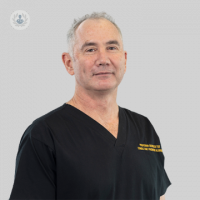Hay fever: the facts you’re just itching to know
Written by:The pollen levels over the summer have been extremely high in the UK due to the extreme weather. Many hay fever sufferers have therefore had a terrible time with this. Esteemed paediatric allergist Professor George Du Toit is here to explain hay fever and how sufferers can deal with it.

What is hay fever?
Hay fever is also known as rhinoconjunctivitis and is an allergic reaction, usually to pollen in the air. Of course, there are other causes of “hay fever”, which are perennial, and these include house dust mites, mould, and pet dander if patients are exposed to pets on a daily basis.
Hay fever can develop early in life, even after only having lived through two or three summers, but generally presents in slightly older children at around four, five, or six years of age. Symptoms may involve the eyes, ears, nose, and throat, as well as the chest and skin.
Spotting the symptoms of hay fever
Patients who are extremely allergic to grass pollen may experience itchy, gritty eyes over the summer season, with symptoms affecting the nose such as nasal obstruction, sneezing, or continuous run and the associated post-nasal drip, with the typical mannerism of throat-clearing noises. The middle ear may be itchy and, with allergic inflammation, hearing may be slightly impaired. In those with extreme allergies, eczema may flare up and the patient may experience wheezing.
In the UK, the spring-based symptoms during February, March and April are usually due to tree pollen, such as birch and alder. Symptoms over the main summer season usually arise due to grass, and then later in the season mould and weeds can play a role.
The classic appearance of patients with hay fever is that of sneezing, itching of the eyes, upward rubbing of the nose (allergic salute), which gives rise to a clear, transverse crease on the nose. Rubbing of the eyes may give two dark patches under the eyes known as “allergic shiners”. Continuous mouth-breathing may give rise to dry, cracked lips and the licking thereof, and lip-sucking may lead to eczema. The continuously dry dentition may be prone to dental caries and a foul-smelling breath. The throat-clearing and post-nasal drip can give rise to irritating throat-cleaning noises.
Managing hay fever
To manage these symptoms, use may be made of front line hay fever medications. Non-sedating anti-histamines should be taken on a frequent basis at the highest indicated dose and eye drops may help with itchy, allergic eyes.
Eyes drops should be initially applied when cool, as this is soothing, and for children who hate having drops placed in their eye, the trick may be to lie on their backs with their eyes closed, and when the drops have been placed on the eyelid, adjacent to the nasal bridge, these drops may gently be blinked into the eye.
Nasal sprays also provide some relief. Saline douches may be used to wash out mucus and the pollen. If this is insufficient, then medicated nasal sprays with low-dose corticosteroids and the addition of nasal antihistamines may provide relief.
Can hay fever be cured?
Ultimately, the only potentially disease-modifying therapy is immunotherapy. This can be given by injection (also known as “allergy shots”), or as sub-lingual immunotherapy (SLIT). SLIT is more commonly used, and generally preferred by many children, especially younger children. However, this requires the placement of the product under the tongue every single day for many months of the year and generally over three sequential years.


